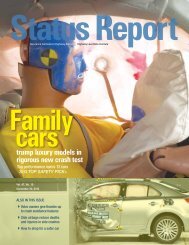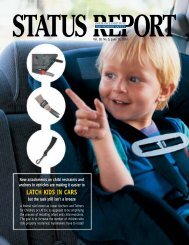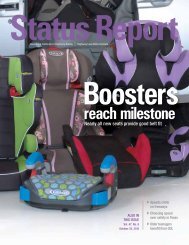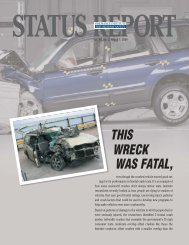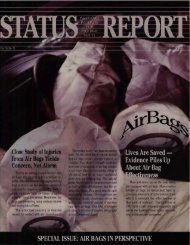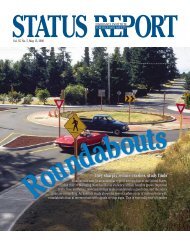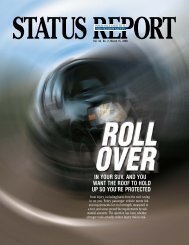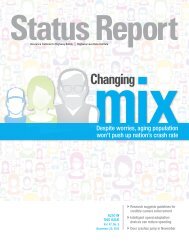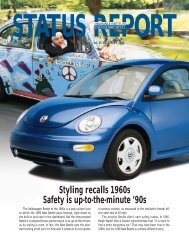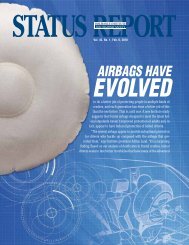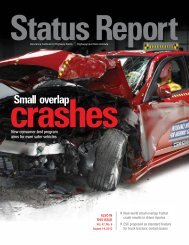IIHS Status Report, Vol. 45, No. 3, March 31, 2010 - Insurance ...
IIHS Status Report, Vol. 45, No. 3, March 31, 2010 - Insurance ...
IIHS Status Report, Vol. 45, No. 3, March 31, 2010 - Insurance ...
- No tags were found...
You also want an ePaper? Increase the reach of your titles
YUMPU automatically turns print PDFs into web optimized ePapers that Google loves.
6 <strong>Status</strong> <strong>Report</strong>, <strong>Vol</strong>. <strong>45</strong>, <strong>No</strong>. 3, <strong>March</strong> <strong>31</strong>, <strong>2010</strong>642ANTILOCK BRAKESON MOTORCYCLESprevent crashesThe best motorcycle crash is the one thatnever happens. One technology designedto reduce the chance of crashing is antilockbraking. The Institute first reported on theeffectiveness of motorcycle antilocks in2008 (see <strong>Status</strong> <strong>Report</strong>, Oct. 22, 2008; on theweb at iihs.org). <strong>No</strong>w 2 new studies, one bythe Institute and one by the affiliated HighwayLoss Data Institute (HLDI), providemore evidence that antilocks reduce fatalcrash risk and lower insurance losses.Stopping a motorcycle is trickier thanstopping a car. For one thing, the front andrear wheels typically have separate brakecontrols. In an emergency, a rider faces asplit-second choice to either brake hard,fatal crashesper 10,000 motorcycle registratIONS,WITH AND WITHOUT ANTILOCKS, 2003-08withoutantilockswithoutwithantilocks antilockswithantilocks0-10-20ple. But the new studies indicate that antilocksreduce crashes overall and save lives.Institute researchers compared the fatalcrash experience of antilock-equipped motorcyclesagainst their nonantilock counterpartsduring 2003-08. The main findingis that motorcycles with antilocks versuswithout are 37 percent less likely to be infatal crashes per 10,000 registered vehicleyears. Bolstering this finding is a separateHLDI analysis of insurance claims filed fordamage to motorcycles. Bike models withantilocks have 22 percent fewer claims fordamage per insured vehicle year than thesame models without antilocks.Drivers younger than 25 have the highestestimated claim frequencies. Wheremotorcyclists ride also affects claims. Thefrequency of claims for crash damage tobikes is 9 percent higher in urban areas withheavy traffic than in moderately congestedinsurance claimspercent reductIONS in collISION lOSSesfor 2003-08 MODelS with antilocks0-10-20claimfrequencyclaimfrequency severityoverall claimseverity losseswhich can lock the wheels and cause anoverturn, or hold back on braking and riskrunning headlong into the emergency. This iswhen antilocks can help by reducing brakepressure when they detect impending lockupand then increasing the pressure again whentraction is restored. Brake pressure is evaluatedmultiple times per second, so ridersmay brake fully without fear of locking up.Antilocks won’t prevent every motorcyclecrash. They won’t help a rider who’sabout to be struck from behind, for examlocales.There were 13 percent fewer claimsin the least populated areas than in mediumdensity ones. The effects of antilocks onclaims were estimated only after controllingfor these and other factors.Antilocks are gaining traction among motorcyclemanufacturers and wider acceptanceamong riders. More than half of motorcycleowners recently surveyed by the Institutesaid they’d get antilocks on their next bike.Buyers can find them now on at least 60 newmodels (go to iihs.org for a list).overalllosses“Motorcycle antilocks do make a difference,”says Institute president Adrian Lund,who also is president of HLDI. “They helpmake traveling on 2 wheels less risky by reducingthe chance of overturning a bike andcrashing. Passenger vehicles still are safer,but if you’re going to ride we’d recommendgetting a motorcycle with antilocks.”HLDI also looked at injury claims.Under medical paymentcoverage, motorcycleswith antilocksregistered 30 percentlower claim frequenciesthan bikeswithout this feature.Claim frequencies were33 percent lower underbodily injury liabilitycoverage.Institute researchersused data from the federalFatality Analysis<strong>Report</strong>ing System and motorcycleregistration recordsfrom R. L. Polk andCompany. HLDI provided antilockfeature informationfrom its proprietary databaseof vehicle features.For a copy of “Effectivenessof antilockbraking systems inreducing motorcyclefatal crashrates” by E.R.Teoh or a HLDIspecial reporton motorcycleantilockbraking systems,write:Publications,<strong>Insurance</strong> Institutefor HighwaySafety, 1005<strong>No</strong>rth Glebe Rd.,Arlington,VA22201; or emailpublications@iihs.org.



